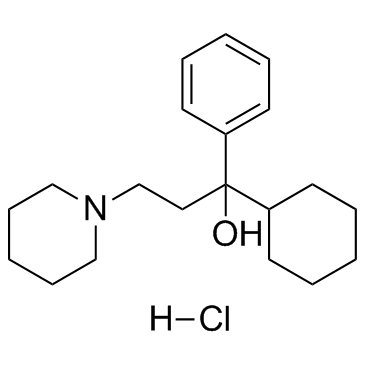Benzhexol hydrochloride

Benzhexol hydrochloride structure
|
Common Name | Benzhexol hydrochloride | ||
|---|---|---|---|---|
| CAS Number | 52-49-3 | Molecular Weight | 337.927 | |
| Density | N/A | Boiling Point | 447.9ºC at 760mmHg | |
| Molecular Formula | C20H32ClNO | Melting Point | 258.5ºC | |
| MSDS | N/A | Flash Point | 211ºC | |
|
Gingival pain: an unusual side effect of ziprasidone.
BMJ Case Rep. 2013 , doi:10.1136/bcr-2012-007577, (2013) The patient is a 52-year-old man with schizophrenia who developed severe, unremitting gingival pain after his ziprasidone dosage was increased from 80 to 120 mg. His physical examination and laboratory findings were unremarkable. He did not have any extra-pyr... |
|
|
A misguided 'pill in the pocket' approach with flecainide leading to cardiac arrest.
BMJ Case Rep. 2012 , doi:10.1136/bcr-2012-006868, (2012)
|
|
|
DYT16: the original cases.
J. Neurol. Neurosurg. Psychiatr. 83(10) , 1012-4, (2012) DYT16 is an autosomal recessive dystonia-parkinsonism due to putative mutations at PRKRA gene. The aim of this study was to describe clinical features providing video documentation of patients with DYT16 dystonia.We examined and videotaped all homozygous carr... |
|
|
Management of status dystonicus in children. Cases report and review.
Eur. J. Paediatr. Neurol. 16(4) , 390-5, (2012) Status dystonicus (SD) is a medical emergency weighed by a relevant morbidity and mortality. It mainly affects patients with primary or secondary dystonia and is often triggered by events such as fever, infections, exposure medications or their abrupt cessati... |
|
|
An anticholinergic reverses motor control and corticostriatal LTD deficits in Dyt1 ΔGAG knock-in mice.
Behav. Brain Res. 226 , 465-72, (2012) DYT1 early-onset generalized torsion dystonia is an inherited movement disorder associated with mutations in DYT1 that codes for torsinA protein. The most common mutation seen in this gene is a trinucleotide deletion of GAG. We previously reported a motor con... |
|
|
Interventions for disorders of eye movement in patients with stroke.
Cochrane Database Syst. Rev. (10) , CD008389, (2011) Eye movement disorders may affect over 70% of stroke patients. These eye movement disorders can result in difficulty maintaining the normal ocular position and difficulty moving the eyes appropriately. The resulting functional disabilities include a loss of d... |
|
|
The clinical syndrome of primary tic disorder associated with dystonia: a large clinical series and a review of the literature.
Mov. Disord 26(4) , 679-84, (2011) The co-occurrence of tics and dystonia as an idiopathic condition has only rarely been reported. We report a series of patients with tics and persistent dystonia, with the aim of determining the prevalence and clinical characteristics of this syndrome.Analysi... |
|
|
Anti-cholinergics for axial symptoms in Parkinson's disease after subthalamic stimulation.
Clin. Neurol. Neurosurg. 114(10) , 1308-11, (2012) We studied the effect of anti-cholinergic therapy on axial symptoms that show a tendency to worsen over time after deep brain stimulation of the subthalamic nucleus (STN-DBS) in patients with Parkinson's disease (PD).We conducted a prospective study of 20 con... |
|
|
Continuation of ECT after recovery from transient, ECT-induced, postictal cortical blindness.
J. ECT 28(1) , 48-9, (2012) Transient, postictal cortical blindness is a rare adverse effect of electroconvulsive therapy (ECT). There is no information on the safety of continuation of ECT in patients who recover from ECT-induced cortical blindness.An 18-year-old woman with paranoid sc... |
|
|
Fatal intoxication because of trihexyphenidyl.
J. Forensic Sci. 56(5) , 1383-6, (2011) Trihexyphenidyl (THP) is an anticholinergic agent with forensic toxicological interest. We present a case of a 59-year-old woman with a history of paranoid disorder, who was found dead in the house where she lived alone. The autopsy findings revealed no marke... |